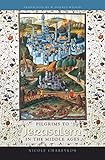Pilgrims to Jerusalem in the Middle Ages / Nicole Chareyron.
Material type: TextPublisher: New York, NY : Columbia University Press, [2005]Copyright date: ©2005Description: 1 online resource (312 p.) : 3 mapsContent type:
TextPublisher: New York, NY : Columbia University Press, [2005]Copyright date: ©2005Description: 1 online resource (312 p.) : 3 mapsContent type: - 9780231132305
- 9780231529617
- 263.04256942
- online - DeGruyter
- Issued also in print.
| Item type | Current library | Call number | URL | Status | Notes | Barcode | |
|---|---|---|---|---|---|---|---|
 eBook
eBook
|
Biblioteca "Angelicum" Pont. Univ. S.Tommaso d'Aquino Nuvola online | online - DeGruyter (Browse shelf(Opens below)) | Online access | Not for loan (Accesso limitato) | Accesso per gli utenti autorizzati / Access for authorized users | (dgr)9780231529617 |
Frontmatter -- CONTENTS -- FOREWORD -- PREFACE -- Chronology And Maps -- Chapter 1. Evagari et Discurrere per Mundum . . . -- Chapter 2. All Roads Lead to Venice -- Chapter 3. Venice in Splendid Dress -- Chapter 4. Five Weeks in a Galley -- Chapter 5. The Holy Lond of Promyssion -- Chapter 6. Jerusalem and the Holy Places -- Chapter 7. The Church of the Holy Sepulcher -- Chapter 8. Pilgrimages and Excursions Round and About Jerusalem -- Chapter 9. Saracens in the Towns, Arabs in the Desert, and Jews Here and There -- Chapter 10. Desert Time, Desert Space -- Chapter 11. Sinai and Its Speaking Stones -- Chapter 12. Cairo, City of Lights -- Chapter 13. Diamonds of the Sands, or Pharaoh's Granaries -- Chapter 14. The Virgin's Garden, the Hermits' Desert, and Egyptian Dreams -- Chapter 15. Alexandria, Sentry of the East -- Chapter 16. Happy He Who, Like Ulysses . . . -- Chapter 17. By Way of an Ending -- Appendix. Pilgrims' Profiles -- Notes -- Bibliography -- Index
restricted access online access with authorization star
http://purl.org/coar/access_right/c_16ec
"Every man who undertakes the journey to the Our Lord's Sepulcher needs three sacks: a sack of patience, a sack of silver, and a sack of faith."-Symon Semeonis, an Irish medieval pilgrim As medieval pilgrims made their way to the places where Jesus Christ lived and suffered, they experienced, among other things: holy sites, the majesty of the Egyptian pyramids (often referred to as the "Pharaoh's granaries"), dips in the Dead Sea, unfamiliar desert landscapes, the perils of traveling along the Nile, the customs of their Muslim hosts, Barbary pirates, lice, inconsiderate traveling companions, and a variety of difficulties, both great and small. In this richly detailed study, Nicole Chareyron draws on more than one hundred firsthand accounts to consider the journeys and worldviews of medieval pilgrims. Her work brings the reader into vivid, intimate contact with the pilgrims' thoughts and emotions as they made the frequently difficult pilgrimage to the Holy Land and back home again. Unlike the knights, princes, and soldiers of the Crusades, who traveled to the Holy Land for the purpose of reclaiming it for Christendom, these subsequent pilgrims of various nationalities, professions, and social classes were motivated by both religious piety and personal curiosity. The travelers not only wrote journals and memoirs for themselves but also to convey to others the majesty and strangeness of distant lands. In their accounts, the pilgrims relate their sense of astonishment, pity, admiration, and disappointment with humor and a touching sincerity and honesty.These writings also reveal the complex interactions between Christians, Jews, and Muslims in the Holy Land. Throughout their journey, pilgrims confronted occasionally hostile Muslim administrators (who controlled access to many holy sites), Bedouin tribes, Jews, and Turks. Chareyron considers the pilgrims' conflicted, frequently simplistic, views of their Muslim hosts and their social and religious practices.
Issued also in print.
Mode of access: Internet via World Wide Web.
In English.
Description based on online resource; title from PDF title page (publisher's Web site, viewed 02. Mrz 2022)


